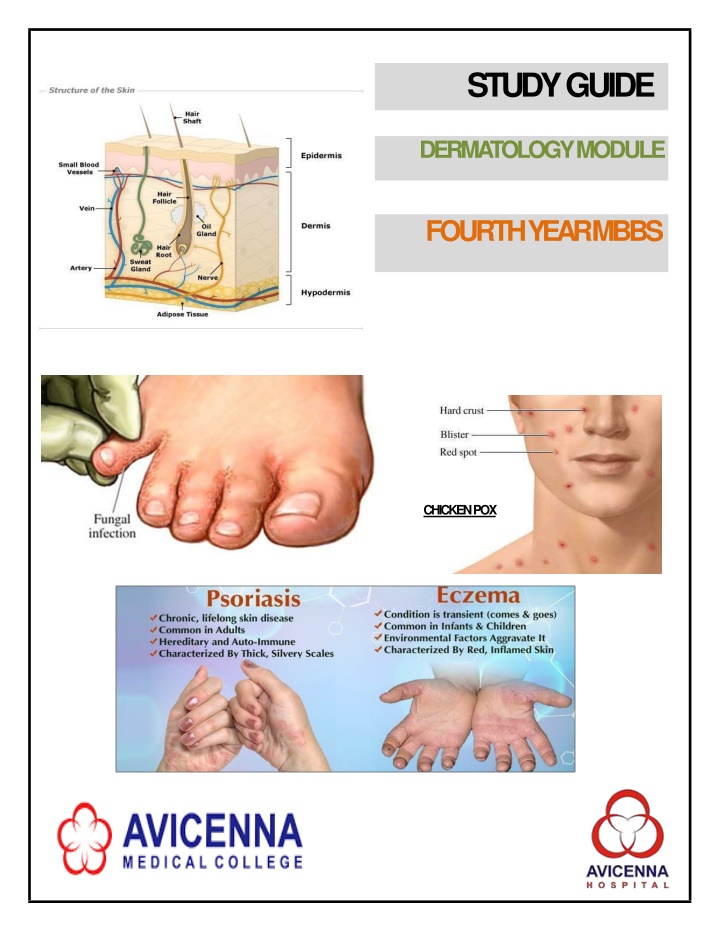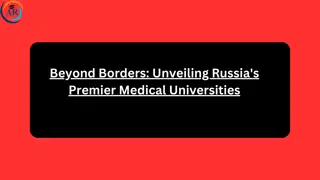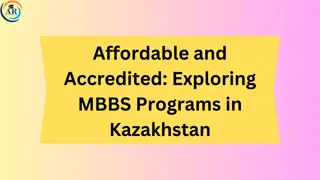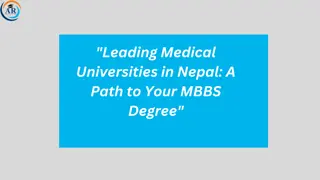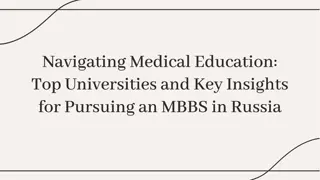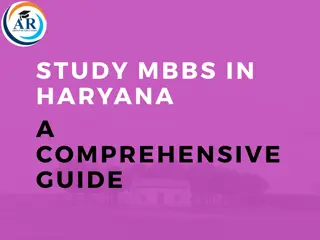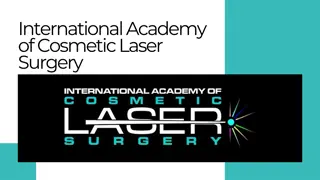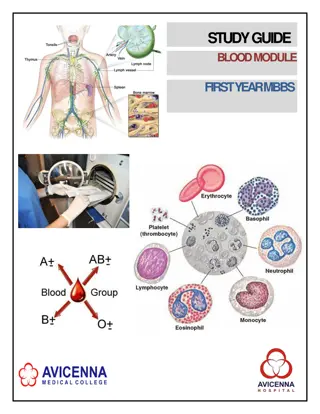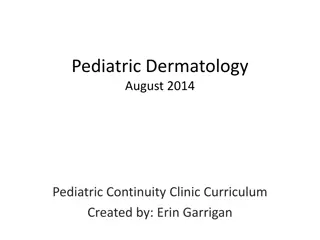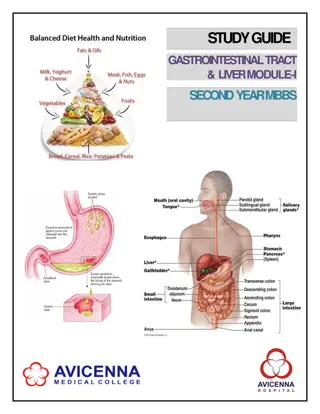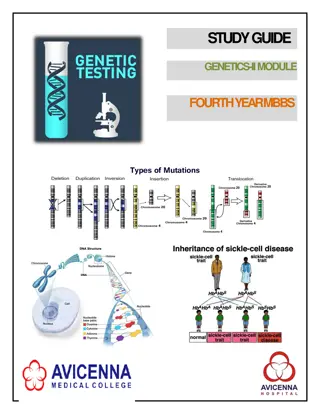Dermatology Study Guide for 4th Year MBBS Students
This study guide focuses on Dermatology for 4th Year MBBS students, providing information on objectives, learning strategies, resources, and assessment methods. It covers the curriculum framework, integrated teaching, and learning experiences to enhance student understanding and performance.
Download Presentation

Please find below an Image/Link to download the presentation.
The content on the website is provided AS IS for your information and personal use only. It may not be sold, licensed, or shared on other websites without obtaining consent from the author.If you encounter any issues during the download, it is possible that the publisher has removed the file from their server.
You are allowed to download the files provided on this website for personal or commercial use, subject to the condition that they are used lawfully. All files are the property of their respective owners.
The content on the website is provided AS IS for your information and personal use only. It may not be sold, licensed, or shared on other websites without obtaining consent from the author.
E N D
Presentation Transcript
STUDYGUIDE DERMATOLOGYMODULE FOURTH YEARMBBS CHICKENPOX
4th YEAR MBBS DERMATOLOGYMODULE LIAQUAT NATIONAL MEDICAL COLLEGE AVICENNA MEDICAL COLLEGE STUDY GUIDE FOR DERMA TOLOGYMODULE Page No. 3 4 5 7 7 8 11 13 13 14 16 17 CONTENTS S.No 1 2 3 4 Overview Introduction to StudyGuide LearningMethodologies Module 2:DERMATOLOGY Introduction Objectives and LearningStrategies Cases for Case-BasedDiscussion LearningResources Additional LearningResources AssessmentMethods Modular Examination Rules and Regulations(AVMC) Schedule 4.1 4.2 4.3 5 5.1 6 7 8 Page | 2
4th YEAR MBBS DERMATOLOGY MODULE AVICENNA MEDICAL COLLEGE Module name: Dermatology Year: Four Duration: 2 weeks Timetable hours: Interactive Lectures, Case-Based Discussion (CBD), Clinical Rotations, Presentations, Demonstrations, Skills, Self-Study MODULE INTEGRA TED COMMITTEE Dr. Abeer Fahad MODULECOORDINATOR: Professor Dr. Rubina Hafeez (Pathology) Professor Dr.Rehana Shahid(Anatomy) CO-COORDINATORS: DEPARTMENTS & RESOURCE PERSONS FACILITA TINGLEARNING BASIC HEALTHSCIENCES CLINICAL AND ANCILLARYDEPARTMENTS FAMILYMEDICINE Professor Dr. Muhammad Luqman ANATOMY Professor Dr.Rehana Shahid BIOCHEMISTRY Professor Dr. Zubair Ahmad MEDICALEDUCATION Professor Dr. Waheed Ahmad COMMUNITYMEDICINE Professor Dr. Rana Muhammad Akhtar Khan INTERNALMEDICINE Dr. Muhammad Usman Amir PATHOLOGY Endocrinology Prof. Dr. Waheed Ahmed Professor Dr. Rubina Hafeez PHYSIOLOGY Professor Dr. Binyamin Ahmad DERMATOLOGY Dr. Abeer Fahad PHARMACOLOGY Professor Dr. Rana Tariq Mehmood AVMCMANAGEMENT Professor Dr. Gulfreen Waheed, PrincipalAVMC Brig.Dr. Gul e Rana , Director AVMC Dr. Sadia Awan Dr. Muhammad Muzzammil Sadiq Dr. Usama Bin Ishtiaq STUDY GUIDE COMPILEDBY: Department of Health CareEducation Page | 3
4th YEAR MBBS DERMATOLOGYMODULE LIAQUAT NATIONAL MEDICAL COLLEGE AVICENNA MEDICAL COLLEGE INTRODUCTION WHAT IS A STUDYGUIDE? It is an aidto: Inform students how student learning program of the module has beenorganized Helpstudentsorganize andmanagetheirstudiesthroughoutthemodule Guide students on assessment methods, rules andregulations THE STUDYGUIDE: Communicates information on organization and management of themodule. Thiswill helpthestudentto contactthe rightpersonin caseof anydifficulty. Definestheobjectiveswhich areexpectedto beachieved at theendof themodule. Identifies the learning strategies such as lectures, small group teachings, clinical skills, demonstration, tutorial and casebasedlearning that will be implemented to achieve the module objectives. Provides a list of learning resources such as books, computer assisted learning programs, web- links,journals,forstudentsto consultin orderto maximize their learning. Highlights information on the contribution of continuous on the student s overallperformance. Includes information on the assessment methods that will be held to determine every student s achievement ofobjectives. Focuses on information pertaining toexamination policy, rules and regulations. CURRICULUMFRAMEWORK Studentswill experience integratedcurriculumsimilar to previousmodules. INTEGRATED CURRICULUM comprises system-based modules such as Eye/ENT, dermatology, genetics, rehabilitation and neurosciences-II & psychiatry modules which links basic science knowledge to clinical problems. Integrated teaching means that subjects are presented as a meaningful whole. Students will be able to have better understanding of basic sciences when they repeatedly learn in relation to clinical examples. LEARNING EXPERIENCES: Case based integrated discussions, Task oriented learning followed by task presentation, skills acquisition in skills lab, computer-based assignments, learning experiences in clinics, wards. Page | 4
4th YEAR MBBS DERMATOLOGYMODULE LIAQUAT NATIONAL MEDICAL COLLEGE AVICENNA MEDICAL COLLEGE INTEGRA TING DISCIPLINES OF DERMA TOLOGYMODULE DERMATOLOGY PATHOLOGY ENDOC RINOLOGY DERMATOLOGY MODULE MEDIC INE PHARMACOLOGY LEARNINGMETHODOLOGIES Thefollowing teaching/ learningmethodsareusedto promotebetterunderstanding: InteractiveLectures Small Group Discussion Case-Based Discussion(CBD) ClinicalExperiences o ClinicalRotations Skillssession INTERACTIVE LECTURES:In large group, the lecturer introduces a topic or common clinical conditions and explains the underlying phenomena through questions, pictures, videos of patients interviews, exercises, etc.Studentsareactively involved in the learningprocess. SMALL GROUP SESSION: This format helps students to clarify concepts, acquire skills or desired attitudes. Sessions are structured with the help of specific exercises such as patient case, interviews or discussion topics. Students exchange opinions and apply knowledge gained from lectures, tutorials and self study. The facilitatorrole isto askprobingquestions,summarize, orrephraseto help clarify concepts. Page | 5
4th YEAR MBBS DERMATOLOGYMODULE LIAQUAT NATIONAL MEDICALCOLLEGE AVICENNA MEDICAL COLLEGE CASE-BASEDDISUCSSION(CBD):Asmallgroupdiscussionformat where learning isfocusedaroundaseries of questions based on a clinical scenario. Students discuss and answer the questions applying relevant knowledge gained previously in clinical and basic health sciences during the module and construct new knowledge. TheCBDwill beprovided bythe concerndepartment. CLINICAL LEARNING EXPERIENCES:In small groups, students observe patients with signs and symptoms in hospital wards, clinics and outreach centers. This helps students to relate knowledge of basic and clinical sciencesof the module andpreparefor futurepractice. o CLINICAL ROTATIONS: In small groups, students rotate in different wards like Medicine, Pediatrics, Surgery, Obs & Gynae, ENT, Eye, Family Medicine clinics, outreach centers & Community Medicine experiences. Here students observe patients, take histories and perform supervised clinical examinations in outpatient and inpatient settings. They also get an opportunity to observe medical personnel working as a team. These rotations help students relate basic medical and clinical knowledgein diverse clinicalareas. Skills relevant to respective module are observed and practiced where applicable in SKILLSSESSION: skillslaboratory. SELF-DIRECTED STUDY: Students assume responsibilities of their own learning through individual study, sharing and discussing with peers, seeking information from Learning ResourceCenter,teachersand resource persons within and outside the college. Students can utilize the time within the college scheduled hours of self-study. Page | 6
4th YEAR MBBS DERMATOLOGYMODULE LIAQUAT NATIONAL MEDICAL COLLEGE AVICENNA MEDICAL COLLEGE MODULE 4: DERMA TOLOGY INTRODUCTION Dermatology is the branch of medicine that deals with skin, mucous membranes, hair and nails. Although relatively straightforward to examine, the skin is the largest organ weighting about 16% of total bodyweight, andhasnumerouspotentialabnormalities. There are about 1500 distinct skin diseases and many variants. About 15% of consultations in general practice relate to a skin problem and between 50% and 75% of individuals may have a skin problem at anytime. Most dermatological conditions are highly visible and can have profound psychosocial effects. Disfigurement can result in negative self-perception, depression, social rejection and social isolation related to unfavorable self-image. Skin conditions affecting the face may require aggressive treatment even if they are clinically relatively mild. Disturbance of body image is particularly serious if it arises during childhood or adolescence,asisthe casefor birthmarks, atopiceczemaandacne. This module will discuss the impact of skin diseases, outline the biology of normal skin, and describe how to examine the skin and how its diseases may be effectively treated. A range of skin infections, inflammatory skin diseases and neoplastic conditions will be briefly described as well as skin signs of systemicdisease. Page | 7
4th YEAR MBBS DERMATOLOGYMODULE LIAQUAT NATIONAL MEDICAL COLLEGE AVICENNA MEDICAL COLLEGE COURSE OBJECTIVES ANDSTRA TEGIES By the end of Dermatology module students shouldbe able to: TEACHING STRATEGY OBJECTIVES DERMATOLOGY Define commonterminologies Differentiate among various skin lesions when shown photographs/realpatients Describe the clinical presentations of common dermatologic conditions listedbelow: I. Infections: a. Bacterial: Impetigo, Ecthyma, Cellulitis,Foliculitis, Furuncle, Carbuncle, Erysiplas,NecrotisingFascitis b. Viral: Herpes Simplex and Zoster, Chicken Pox, Measles, Interactive Lectures Viral warts,MolluscumContagiosum c. Fungal: Dermatophyte infections, CandidaAlbicans, PityrisisVersiclor d. Parasitic: Scabies, Pediculosis,Leishmaniasis I. Psoriasis II. III. Lichen Planus Cutaneous drugs reactions: Steven Johnson Syndrome, Toxic Epidermal Necrolysis, Erythema Multiformis,Urticaria IV. Cutaneous Manifestations of Systemic Diseases: skins changes in SLE, Thyroid disorders, Hepaticdisorders. Diagnose common dermatologic conditions listed abovebased oninformation providedin writing or bysimulatedpatients Interactive Lectures Justify management plan for the conditionslisted above Page | 8
4th YEAR MBBS DERMATOLOGYMODULE AVICENNA MEDICAL COLLEGE LIAQUAT NATIONAL MEDICAL COLLEGE Discuss the clinical presentations, diagnosis andmanagement Interactive Lectures plan ofEczema Discuss the clinical presentations, diagnosis andmanagement plan of Atopicdermatitis Case- Based Discussion Discuss the clinical presentations, diagnosis andmanagement plan for Bullous disorder including Pempigus Vulgaris, Bullous Pemphigoid, Dermatitis Herpetiformis, EpidermolysisBullosa Discuss the causes, pathogenesis, diagnosis and treatment of acne Interactive Lectures Discuss the causes, pathogenesis, diagnosis and treatment of alopecia (hairfall) ENDOCRINOLOGY Describe the clinical presentations of commondermatologic conditions of DiabetesMellitus Interactive Lecture INFECTIOUSDISEASE Describe the clinical presentations of SexuallyTransmitted Diseases which include Gonorrhoea, Chancroid, Syphilis, Interactive Lecture Lymphogranuloma Venerum (LGV), Granuloma Inguinale MEDICINE Discuss the clinical presentations of commondermatologic conditions related to kidney disorders &malignancies including Para-NeoplasticSyndrome SmallGroup Discussion List the drugs that can cause drugreactions Describe the skin manifestation of drugreactions Interactive Lecture PATHOLOGY Infectious diseases of skin Discuss common infections of skin including Verrucae (warts), Interactive Lectures MolluscumContagiosum, Impetigo, superficial fungalinfection Page | 9
4th YEAR MBBS DERMATOLOGYMODULE LIAQUAT NATIONAL MEDICAL COLLEGE AVICENNA MEDICAL COLLEGE Acute and chronic inflammatory dermatoses Explain the pathogenesis and clinical presentations of various acute & chronic inflammatory dermatoses including Urticaria, Interactive Lectures Acute Eczematous Dermatitis, Erythema Multiforme Psoriasis, SeborrheicDermatitis, LichenPlanus Disorders of pigmentation and vesicular (Bullous) Diseases Discuss pigmentation disorders including Freckle, Lentigo, Nevi SmallGroup Discussion andMelanoma Describe pathogenesis and clinical features of various blistering disorders of skin Tumors of dermis and epidermis Classify tumors of skin andsubcutis Describe important types with pathogenesis, morphology and Interactive Lectures clinical features of skin tumors (Actinic Keratosis, Squamous Cell Carcinoma, Basal Cell Carcinoma, Dermato-fibroma, dermatofibrosarcomaprotuberance) PHARMACOLOGY Discuss the uses, mechanism of action, contraindication,precautions and side effects of topical as well as systemic antifungaldrug Interactive Lectures Discuss drugs used in other dermatologicaldisorders Case- Based Discussion Discussclassificationandmechanismof action of oral & topical steroids Lecture Apart from attending daily scheduled sessions, students too should engage in self-study to ensure that all the objectives arecovered Page | 10
4th YEAR MBBS DERMATOLOGYMODULE LIAQUAT NATIONAL MEDICAL COLLEGE AVICENNA MEDICAL COLLEGE Case for Week1 9-months- old babygirl isbrought to the skin clinic byher mother, who is concerned about her rash. Shetold the doctor that it started when shewas3months old. Initially it wasobserved onher cheeksandchin. Nowit effectsherextremities.It isintermittentandintenselyitchy. Past history only significant for rhinitissince birth. She denies any family history of skin rash. Her sister isasthmatic. On examination, child is sitting comfortably, is attentive, following commands and appropriatelyinteractive. Vitals are stable. Herskinexamination showsill defined, symmetric, brightly erythematous scaling pink patches on her cheeks, milder on chin and extremities. Diaper area is not involved. Restof the systemic examination is unremarkable. 1.What is the most likelydiagnosis? 2.How do you classify thisdisease? 3.What is the age related distribution ofthis type? 4.How would you treat thiscase? 5.How would you counsel her parents about herdisease? Page | 11
4th YEAR MBBS DERMATOLOGYMODULE LIAQUAT NATIONAL MEDICAL COLLEGE AVICENNA MEDICAL COLLEGE Case for Week2 A 30-year-old lady presented to a dermatology clinic with painful oral ulcers forlast one month. a. Physical examination showed wide spread erosions of oral mucosa and close examination revealed friable mucous membrane and ill-defined apthaous ulcer. A polycyclic lesion with blistering evidentat themarginpresentoverthe trunk. Questions 1. What are the differentialdiagnoses? 2. What is the diagnosis? b. Biopsy of peri-lesion mucosa showed acantholysis. Direct imunoflourence demonstrates an intra epidermal band IgG and c3. Empidermis showed focal collection ofeosinophills. 3. Classify the disease on the basis of level of blisters on histopathological ground. 4. What are the complications of thisdisease? 5. How will you manage this patient? Page | 12
4th YEAR MBBS DERMATOLOGYMODULE LIAQUAT NATIONAL MEDICAL COLLEGE AVICENNA MEDICAL COLLEGE LEARNINGRESOURCES SUBJECT RESOURCES REFERENCEBOOKS: 1. Hutchison s Clinical Methods, 23rdEdition 2. MacLeod's clinical examination 13thedition 3. Davidson's Principles and Practice ofMedicine 4. Kumar and Clark's ClinicalMedicine GENERALMEDICINE TEXTBOOKS 1. Robbins & Cotran, Pathologic Basis of Disease, 9thedition. 2. Rapid Review Pathology, 4th edition by Edward F. GoljanMD PATHOLOGY/MICROBIOLOGY WEBSIT ES: 1. http://library.med.utah.edu/WebPath/webpath.html 2. http://www.pathologyatlas.ro/ PHARMACOLOGY 1. Lippincot IllustratedPharmacology 2. Basic and Clinical Pharmacology byKatzung ADDITIONAL LEARNINGRESOURCES Hands-on Activities/PracticalStudents will be involved in Practical sessions and hands-on activitiesthat link with theDermatologyModule to enhance learning. Models available in the museum are a rich learning resource forquick Museum review of anatomy and relatededucational activities Skills acquisition in a simulated environment in theskills lab involving experiential learning will ensurepatientsafety andwill alsohelp to build SkillsLab confidence in approaching thepatients Videos and podcasts will familiarize the student withthe procedures and protocolwhich theycanwatch andlistento at anytimeandwherever they Videos/Podcasts are, as part of task orientedlearning Students will use easily accessible internet resources with added time InternetResources flexibilityto enrichandupdatetheirknowledge anditsapplication Page | 13
4th YEAR MBBS DERMATOLOGYMODULE LIAQUAT NATIONAL MEDICAL COLLEGE AVICENNA MEDICAL COLLEGE ASSESSMENTMETHODS: Theory: o Best Choice Questions (BCQs) also known as MCQs (Multiple Choice Questions) are used to assess objectives covered in eachmodule. A BCQ has a statement or clinical scenario followed by four options (likelyanswer). Students after reading the statement/scenario select ONE, the most appropriate response fromthe given list ofoptions. Correct answer carries one mark, and incorrect zero mark . There is no negative marking. Studentsmarktheirresponsesonspecifiedcomputer-based/OMRsheetdesignedforAVMC OSPE/OSCE: Objective Structured Practical/ClinicalExamination: Eachstudentwill beassessedonthe samecontentandhavesametimeto completethe task. Comprise of 12-25stations. Each station may assess a variety of clinical tasks, these tasks may include history taking, physical examination, skills and application of skills andknowledge Stations are observed, unobserved, interactive and reststations. Observed and interactive stations will be assessed by internal orexternal examiners. Unobserved will be static stations in which there may be an X-ray, Labs reports, pictures, clinical scenarioswith relatedquestionsforstudentstoanswer. Rest station is a station where there is no task given and in this time student can organize his/her thoughts. InternalEvaluation Students will beassessedto determine achievement of moduleobjectivesthroughthefollowing: Module Examination: will be scheduled on completion of each module. The method of o examination comprises theory exam which includes BCQs and OSPE (Objective Structured Practical Examination). Graded Assessment of students by Individual Department: Quiz, viva, practical, assignment, small o group activities such as CBL, TBL, TOL, online assessment, ward activities, examination, and log book. Marksof bothmodular examinationandgradedassessmentwill constitute 20%weightage. As per UHS policy, this 20% will be added by UHS to Final TheoryExamination. Page | 14
4th YEAR MBBS DERMATOLOGYMODULE LIAQUAT NATIONAL MEDICAL COLLEGE AVICENNA MEDICAL COLLEGE Example : Number of Marks allocated for Final Theory and Internal Evaluation InternalEvaluation (Class test +Assignments + Modular Exam) 20% Final Examination TheoryMarks Total(Theory) 80% 100% FormativeAssessment Individual department may hold quiz or short answer questions to help students assess their own learning. The marks obtained are not included in the internalevaluation More than 75% attendance is needed to sit for the modularexaminations Page | 15
4th YEAR MBBS DERMATOLOGYMODULE AVICENNA MEDICAL COLLEGE LIAQUAT NATIONAL MEDICAL COLLEGE MODULAR EXAMINATION RULES & REGULATIONS(AVMC) Studentmustreportto examinationhall/venue, 30 minutesbeforetheexam. Exam will begin sharp at the giventime. No student will be allowed to enter the examination hall after 15 minutes of scheduled examinationtime. Studentsmust sitaccordingto theirroll numbersmentioned ontheseats. Cell phones are strictly not allowed in examinationhall. If anystudentisfoundwith cell phonein anymode(silent, switchedoffor on)he/shewill benot be allowed to continue theirexam. No students will be allowed to sit in exam without University Admit Card, AVMCCollege ID Card and LabCoat Student must bring the following stationary items for the exam: Pen, Pencil, Eraser, and Sharpener. Indiscipline in the exam hall/venue is not acceptable. Students must not possess any written materialorcommunicatewith theirfellowstudents. UHS GradingSystem It will be based on GPA 4system Marks obtained in Percentagerange NumericalGrade AlphabeticalGrade 80-100 4.0 A+ 75-79 4.0 A 70-74 3.7 A- 67-69 3.3 B+ 63-66 3.0 B 60-62 2.7 B- 56-59 2.3 C+ 50-55 2.0 C <50 Un-grade-able 0 U A candidate obtaining GPA less than 2.00 (50%) is declared un-graded(fail). Cumulativetranscriptisissuedat the endof clearance of all modules. Page | 16
